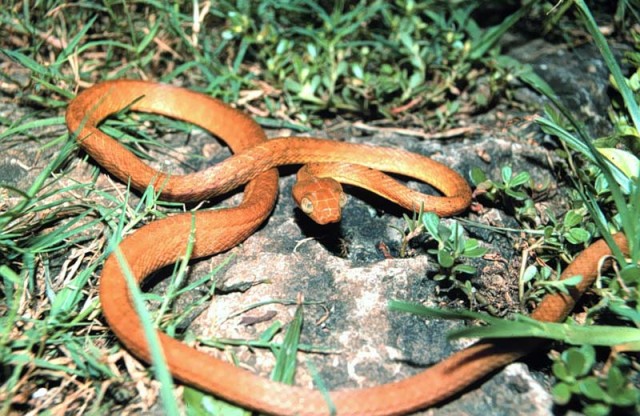Snakes on a Boat

The brown tree snake, pictured above, typically grows to a length of about one to two meters — about three to seven feet. While venomous, they’re generally considered harmless to people (especially adults; children bitten by a brown tree snake may be at risk). Their typical diets consist of small rodents, some birds, lizards, and even bats. They are native to Papua New Guinea, some other islands nearby, and the northern and eastern coasts of Australia. Populations of feral pigs and mangrove monitors (a type of monitor lizard) prey on the brown tree snakes, keeping their populations in check. They can’t swim or, thank heavens, fly (yikes!), so they are pretty much trapped in these areas.
Unless they get on a boat.
Guam is a tiny U.S territory in the western Pacific. The island has a population of about 150,000 people and is located about 1,400 miles (2,200 km) north of Papua New Guinea, with nothing but ocean between the two. By all rights, there should be no brown tree snakes there. But sometime in the 1940s or early 1950s, the reptiles started appearing on the island, most likely after finding accidental passage on a cargo ship. Guam doesn’t have any feral pigs or mangrove monitors, so there is nothing keeping the invasive snake population there unchecked.
Given free rein, the snakes destroyed large parts of Guam’s ecology. As Science Daily reported, the snakes wiped out the most of the native bird population on Guam and may have even destroyed some species of trees. Because the birds ate spiders, Guam’s spider population is now also incredibly high — there are spider webs everywhere. And the damage isn’t limited to the island’s flora and fauna; the snakes have been known to attack pets and interfere with power lines, thereby causing power outages. As of 2008, per NPR, there are as many as two million brown tree snakes in Guam — ten per person with plenty to spare. The snakes’ presence on the island is often cited as one of the worst examples of a non-native species causing massive amounts of sometimes irreversible harm.
To prevent the snakes from boarding another ship (or a plane) and causing a second Guam-like disaster, authorities employ snake-sniffing dogs to ferret them out of cargo. In general, this has been successful, although snakes have been sighted on other islands (but typically are caught before they spread). But fighting the population on Guam itself? That’s proven tricky. The population is too large to simply use traps or other traditional means of population control, and bringing in a natural predator comes with its own risks. (As noted on these pages earlier, feral pigs are a problem throughout much of the continental United States.) Further, the snakes reside in trees — hence the name — and many would be able to outlast a temporarily-introduced predator.
But not all hope is lost. In February of this year, the U.S. Department of Agriculture announced a new program. As reported by the Guardian, the USDA planned on spiking dead mice with acetaminophen (the active drug in Tylenol), which is poisonous to the snakes. Because acetaminophen is toxic to other animals as well, the USDA planned on outfitting the mice with little parachutes; this way, the little trap snacks would be more likely to get caught in the trees than fall to the ground.
Bonus fact: Hank Johnson is a member of the U.S. House of Representatives from Georgia, a position he has held since 2007. In March of 2010, the House Armed Services Committee invited Admiral Robert F. Willard, the commander of the U.S. Pacific Command, to a hearing regarding the opening of a Marine base on the island of Guam. During the hearing, Johnson asked Admiral Willard if doing so would put the island at risk, stating “[m]y fear is that the whole island will become so overly populated that it will tip over and capsize.” (Here’s a video; the statement is at about the 1:15 mark.) Willard, of course, stated there was no such risk of an island capsizing (?), and Johnson later stated that the comment was a deadpanned joke.
From the Archives: The Aptly-Named Snake Island: It’s not Guam. It’s scarier.
Related: “Problem Snake Management: The Habu and the Brown Treesnake,” book which may come in handy if you end up with a small amount of invasive tree snakes.
